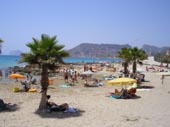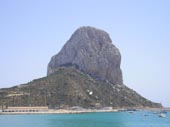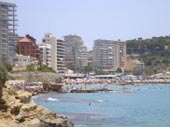Calpe Alicante
Guide to the popular coastal resort of Calpe Alicante, Spain.



Resorts of Alicante - Calpe
Calpe Alicante:- Calpe is located on the Northern Costa Blanca coastline between Altea and Jávea about 67 kilometres north of Alicante and can be reached via the AP-7 motorway or by the N332 coastal road, it is within the Communidad de Valencia.
Calpe was for centuries just a tiny fishing village but these days is a popular tourist hot spot. Renowned primarily for the spectacular rock formation the Penon de Ifach which dominates the skyline of the town, Calpe has a long and chequered history. Its fine old fishing port, modern marina and superb, golden, sandy beaches attract sun-seekers from all over the world as well as the Spanish themselves who love Calpe and this entire coastline. Calpe has a population of about 22,000 with around 50% being of foreign nationality.
Calpe Weather:- Calpe has a warm and even Mediterranean climate with a mean annual temperature of about 20° Centigrade. Temperatures vary from a low of around 5° Centigrade in the winter to highs exceeding 40° Centigrade in the summer months of July and August.
Calpe Alicante History:- Calpe was certainly the site of Iberian (ancient Spanish peoples) settlements and later the Romans built a fish salting factory at Los Banos de la Reina close to the modern day promenade. During the Moorish Occupation the Castle of Calpe was built and Calpe was ruled by the Arab invaders until around 1240 when it was re-conquered by the Christian monarch Jaime I of Aragon (The Conquistador). In 1290 a little settlement named Ifach was begun by the Aragonese admiral Roger de Lauria and located on the inclines of the Penon de Ifach and some time later under King Pedro II of Aragon, the walls of the settlement were strengthened and fortified to ward off attacks from Berber pirates who were rampant in this region. In 1359 during the War of the Two Pedro's (Pedro II of Aragon and Pedro I of Castille) the settlement of Ifach was razed to the ground and its citizens took refuge in a farm house on a hill overlooking the bay and this became the base around which the modern day Calpe grew and developed. The town which energed was a walled and fortified town, necessary at the time, as there were frequent attacks from Berber marauders and in 1637 Calpe was sacked and pillaged and 290 of its people taken to Algiers in North Africa, where they remained captive for five years before finally being released in exchange for prisoners and gold.
Calpe at this time had only about three hundred and fifty inhabitants. During the Seventeenth Century an growth in population resulted in a number of Calpe's inhabitants needing to reside outside of the town's walls and during the Eighteenth Century several projects were begun to extend the town walls in order to encircle this growth and development. This carried on into the Nineteenth Century when there was a significant increase in the seabord activities of Calpe - fishing and other related industries became more important, as did the production of salt (Calpe has its own salt marshes). In the 1930's vestiges of a tourist industry began and this continued in Calpe throughout the 1940's and 1950's and grew more rapidly during the 1960's. Fishing, agriculture (raisins, almonds and carob beans) and salt production had been the main sources of Calpe's wealth right up until the beginnins of tourism which has now taken over as the primary money earner.
Places to Visit in Calpe:- There is plenty to see and do in and around Calpe, everyone will without doubt want to visit the breathtaking Penon de Ifach rock formation, nowadays a protected Natural Park, it was formerly used as a watchtower from which the people of Calpe could spot raiding Berber pirates. It is now possible for visitors to reach the top of the 330m high rock (a tunnel was dug in 1918 to make the climb easier) and thus enjoy stunning views of Calpe and the coastline. The number of people allowed on the Peñon at any one time is however restricted - so it is advisable to arrive early particularly during the busy months. Also worth visiting are the fishing port, the Archaeological Museum, the Festival Museum, the Hermitage of San Salvador, Mariners Square. Not too far way is the slick tourist resort of Benidorm with its many fine facilities, entertainment and attractions.
Calpe Beaches:- One reason to visit the town is the wonderful Calpe beaches. There are a good number of excellent beaches both in and around Calpe, some of the better known ones include Cala Morelló - sandy, Playa Cantal Roig - sandy, Cala La Manzanera - pebbles, Cala Calalga - pebbles, Playa Puerto Blanco - sand and pebbles, Cala El Racó - pebbles, excellent for diving and fishing.
Calpe Links: Calpe Guide - Calpe Map - Calpe Weather - Penon de Ifach - Calpe Beaches - Calpe Spain - Calpe History
Calpe Hotels: Diamante Calpe - Calpe Hotels
Nearby Places: Benidorm - Denia - Moraira - Altea - Albir - Javea - Guadalest - Callosa d'en Sarria - Finestrat - Benissa - Cumbre del Sol - Alfaz del Pi
Attractions: Terra Mitica - Aqualandia - Mundomar - Terra Natura - Penon de Ifach - Caves of Canelobre - Fuentes de Algar - Penyal D'Ifac
Golf Courses: Ifach Golf Club - Real Faula Golf - Spain Golf
Related: Alicante - Valencia - Alicante Weather - Alicante Transfers - Spain - Builders
HOME
